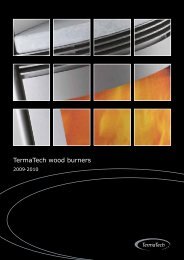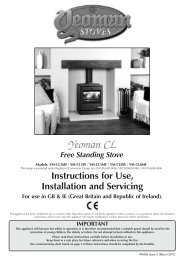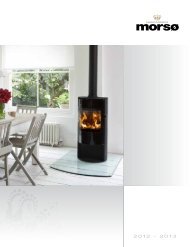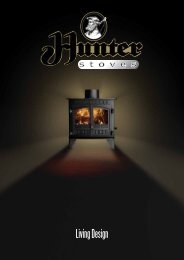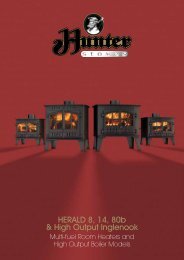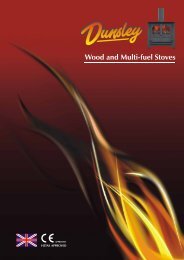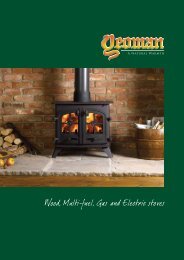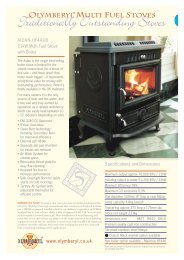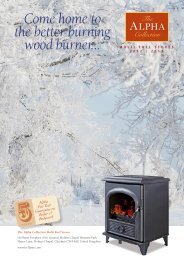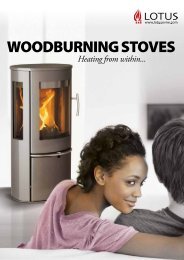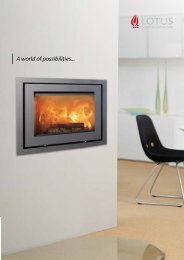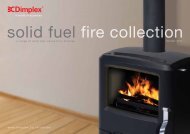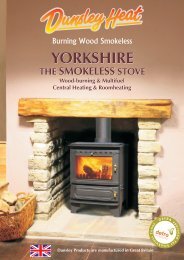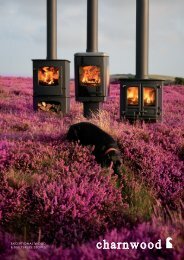Create successful ePaper yourself
Turn your PDF publications into a flip-book with our unique Google optimized e-Paper software.
THE FLUE SYSTEM…<br />
…THE ENGINE OF THE <strong>STOVE</strong><br />
FLUE DRAUGHT AND COMBUSTION<br />
<strong>The</strong>re are three important considerations necessary to maximise the<br />
performance of your stove:<br />
1. Perfect post-combustion with pre-heated air – automatic tertiary air.<br />
2. <strong>The</strong> correct fuel – good burning, well-seasoned wood with less<br />
than 18 % moisture content.<br />
3. a flue system with good up-draught – the ‘engine’ of the stove.<br />
a stove does not produce its own up-draught. This is created through<br />
differences in air pressure between the inside of the house and the<br />
pressure of the outside air caused by the difference between the two<br />
temperatures causing the normally warmer internal air to rise through<br />
the flue system. a chimney with the wrong dimensions (ie a much<br />
greater cross-section than the stove flue outlet) will hinder the development<br />
of good up-draught. Weather and atmospheric conditions will<br />
also affect the draught performance.<br />
all Dan SKan stoves are manufactured using the latest laser technology<br />
to create a uniform quality criteria to ensure that they all deliver<br />
the same special high performance combustion, but like a car this performance<br />
will very much depend upon a good engine and good fuel.<br />
SIMPLE PERFORMANCE TESTS<br />
if you want to test the performance of the stove yourself, try the<br />
following simple tests:<br />
1. Safety Match Test for Up-draught<br />
When the stove is cold, open the stove door – just a small gap, and<br />
then hold a burning match just in front of the gap (about 50 mm / 2").<br />
if the flame is drawn into the fire chamber, the flue system has updraught.<br />
However, if the flame is not drawn in, or is pushed outwards<br />
into the room then the flue could have no up-draught at all or possibly<br />
a down-draught problem. if the match is drawn in so strongly that it<br />
goes out, then you probably have very good up-draught.<br />
2. Ash Pan Fire Test for Air Wash Function<br />
With the ClaSSiC linE, again, when the stove is cold, fully open the<br />
pull control, then open up the ash pan and place crumbled-up<br />
newspaper inside it. after setting the paper alight, quickly close up<br />
the ash pan, making sure it is fully closed. You should see smoke,<br />
firstly coming out of the lower air wash channels (towards the base<br />
of the window) and eventually coming out of the upper air wash<br />
channels. This demonstrates that the air wash channels are open<br />
and functioning properly.<br />
3. Soot Test for Fuel Quality<br />
Should you see persistent carbon deposits on the fire chamber fittings<br />
or darkening of the glass then we recommend that you undertake<br />
the following simple visual checks. remove the Skamol panel or<br />
‘lid’ at the inside top of the fire chamber or alternatively remove the<br />
inspection hatch on the flue pipe. Check for the build-up of flakey<br />
soot / carbon which may also have an unpleasant acrid smell would<br />
be a clear sign that poor quality or damp fuel has been burned.<br />
<strong>The</strong>se deposits could eventually ‘fur’ up the flue system, reduce the<br />
up-draught, or potentially cause a chimney fire. a fine covering of<br />
dry ash powder which can be easily rubbed away with your finger is<br />
perfectly normal.<br />
CORRECT DIMENSIONS OF THE CHIMNEY / FLUE<br />
SYSTEM<br />
<strong>The</strong> prerequisite for a proper functioning stove is the suitability of the<br />
chimney or flue system (minimum cross-section, effective stack height<br />
and positioning etc.) which should conform to all local and national<br />
Building regulations – Document J for England & Wales (Scotland and<br />
northern ireland have their own versions) and approved Document J:<br />
Heat Producing appliances for the republic of ireland.<br />
Chimneys with a cross-sectional internal diameter of more than 200<br />
mm (8") and / or less than 5 m (15") stack height measured from the<br />
top of the fire box could cause draught problems.<br />
in our experience the simplest and most cost-effective way to reduce<br />
the cross-sectional diameter of an existing chimney is to fit an<br />
approved solid fuel flexible chimney liner of approximately 150 mm<br />
(6") diameter.<br />
Your installer or Dan SKan partner will be able to advise you on<br />
this as well as various methods to compensate for insufficient stack<br />
height and poor up-draught. a chimney or flue system which matches<br />
the flue outlet diameter of the stove combined with a flue height of<br />
more than 6 m (20") is advantageous and strongly recommended.<br />
<strong>The</strong> chimney or flue system internal pressure should ideally reach at<br />
least 11 or 12 Pa.<br />
HEATING IN THE TRANSITION BETWEEN SUMMER AND<br />
WINTER<br />
in the autumn air temperatures can vary extremely quickly and this<br />
could adversely affect your flue draught and the performance of your<br />
76<br />
stove, making it difficult to light the fire and making it very slow to burn<br />
as normal. For example, a sudden rise in temperature will disturb the<br />
pressure balance that normally makes the flue work so that the flue<br />
gases find it difficult to rise. Strong winds can have a similar effect and<br />
is most noticeable when opening the stove door to add fuel.<br />
if in doubt always try the safety match test discussed above. Using<br />
this method you can easily see whether you have sufficient up-draught<br />
or if there is likely to be a down-draught problem.<br />
in such instances we always recommend lighting with the ‘top fire’<br />
method described on the inside back cover of this brochure and with<br />
a larger than normal ‘pre-fire’ to help get the draught moving in the<br />
right direction.<br />
it is important that before you light the larger pre-fire you open a<br />
window or door (in the opposite direction of the wind) so that a lower<br />
pressure can be quickly achieved in the room where the stove is<br />
located than that in the flue system. Once your fire begins to burn<br />
normally then the door or window should be closed.<br />
MAINTAINING A CLEAN BURN<br />
To maintain a high performing clean burning stove you must ensure<br />
that the flue gases always move through the chimney or flue system<br />
as quickly as possible limiting anything which might slow them down<br />
and therefore cool the gas and smoke to the point where they can<br />
create creosote and soot deposits which will further enhance the<br />
slowing and cooling process. We recommend that the flueways are<br />
cleaned by an experienced chimney sweep at least once a year<br />
and preferably before the beginning of the heating season. <strong>The</strong><br />
performance of the air wash system and its ability to maintain a clean<br />
glass, both up and down, will also depend on the speedy removal of<br />
the flue gases through a flue system which has a good up-draught.<br />
Smoke escaping from the stove into the room during reloading could<br />
indicate that you have a temporary problem with the weather<br />
conditions. Persistent smoke escape could indicate a problem with<br />
the flue system, possibly sooting up, and this should be investigated<br />
as a matter of urgency by the installer or chimney sweep. if you plan<br />
to use an existing chimney which has a much greater cross-sectional<br />
area than recommended by Dan SKan (see page 85) then it is probably<br />
advisable to choose a stove with double doors, where only one door<br />
needs to be opened for refuelling, thus limiting the disturbance to the<br />
fire chamber pressure and up-draught.<br />
ENCOURAGING FLAMES<br />
a good chimney draught depends on good flames. Without heat<br />
producing flame the up-draught is limited and so too is the air wash<br />
performance.<br />
remember that poor burning woods (eg laburnum, leylandii etc)<br />
and damp or unseasoned wood with a moisture content of more<br />
than 18% will produce a lot of smoke and soot as well as a very poor<br />
flame. Slow burning hardwoods, such as Beech and Oak, work better<br />
when started with some highly flammable wood such as Spruce or<br />
Pine to encourage the flames.<br />
Beech wood contains a lot of tar and is better mixed to help reduce<br />
the sticky black spots it may leave on the glass, which even our<br />
superior air wash system will find difficult to clear.<br />
if the fire has burned down so that only a few embers are left, when<br />
any new fuel is added, always open the glass door slightly to encourage<br />
a strong up-draught which will perform like a blacksmith‘s<br />
bellows and quickly help the new logs to light. This should only take<br />
a minute or two and then the door should be closed to avoid dangerously<br />
over-firing the stove.<br />
PROMOTING A GOOD UP-DRAUGHT<br />
always start your fire with a good starting or pre-fire – this will save time<br />
in the long run (see the inside back cover for our ‘Top fire’ instructions).<br />
Only when the whole system, the stove and the chimney, have good<br />
basic heat throughout, can the correct conditions for an efficient<br />
up-draught and clean burning be achieved. Only a warm system can<br />
supply sufficient up-draught.<br />
When it is very cold outside then the bigger your pre-fire should be so<br />
that the rising hot gases from the pre-fire quickly warm the flue system<br />
to encourage a good up-draught – just like starting an engine!<br />
if your chimney or flue system performs poorly then you may be able<br />
to improve this by reducing the size of the baffle plate by trimming a<br />
little bit at a time from the front edge until you arrive at the best ‘setting’.<br />
<strong>The</strong> Skamol baffle plate can be easily cut using a manual saw or<br />
electric jig-saw. You can even try operating the stove without the<br />
baffle plate.<br />
This will be safe because your Dan SKan stove is manufactured to<br />
the highest standards so that the bodywork will easily withstand the<br />
heat and still remain perfectly stable.



